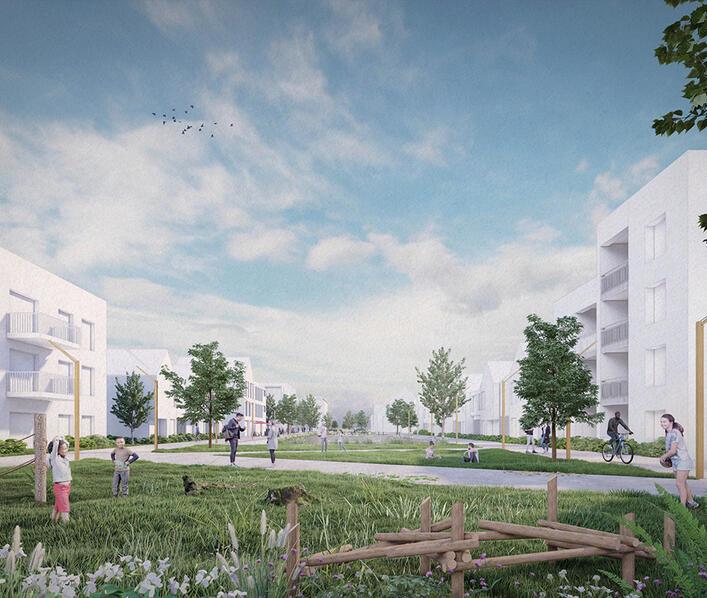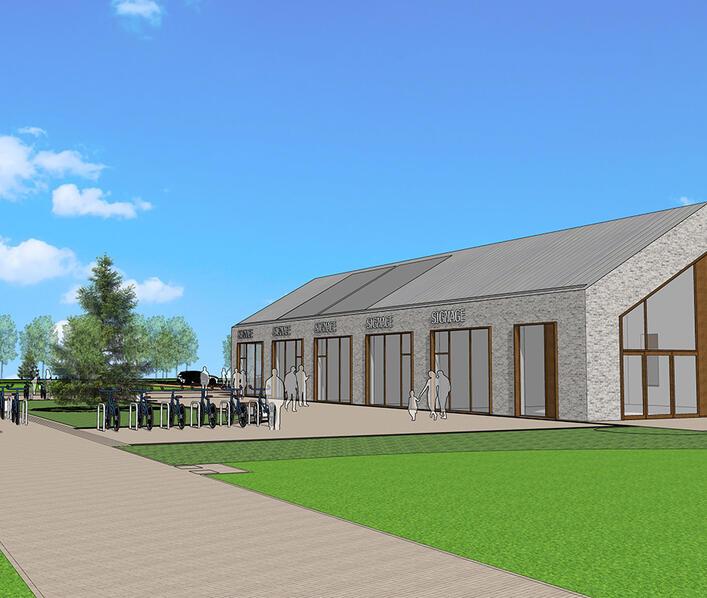Topping out ceremony marks milestone for Alconbury Weald
- 14.10.2015

Local dignitaries, stakeholders and contractors joined Urban&Civic yesterday (8 October) at the topping out ceremony to mark the completion of the external façade of its new Club building at Alconbury Enterprise Campus.
Designed by AHMM, the architects who created the award-winning Incubator, the Club sits further along the tree-lined boulevard at the threshold between the residential and commercial zones at Alconbury Weald.
The three-storey building, which utilises the same material palette as the Incubator, will provide a café, gym, meeting rooms and event space for businesses on the growing site and in the wider area. It will also provide a new base for the expanding Urban&Civic team, acting as the Campus HQ for events and visitors.
Robin Butler, Managing Director of Urban&Civic said: “This is an important milestone for the project. Following 18 months of hard work preparing the 70 acres of the first phase, the Club will deliver important facilities for businesses and people and heralds the start of a series of new buildings and new businesses coming to the Campus.”
Continuing its commitment to maximise the jobs and skills opportunities locally, Urban&Civic appointed RG Carter, a local family-run construction company with offices throughout the East of England, to carry out the work.
David Drake, Director for RG Carter, said: “We are delighted to be working with Urban&Civic on this exciting project. Their open and collaborative approach stimulates real team work as we work towards our shared goal of providing this innovative, quality building as part of a modern community at Alconbury.”
The Club ceremony also marks the end of the first phase of infrastructure work which has seen over £20m spent on demolition and remediation work, and new power, water and digital connections going in to prepare the ground for the next phase of over 800,000 sq ft of commercial space. The investment included £5m from the Government’s Building Foundations for Growth fund, secured in partnership with Huntingdonshire District Council and the Greater Cambridge Greater Peterborough Enterprise Partnership.
Cllr Jason Ablewhite, Executive Leader of Huntingdonshire District Council and a member of the LEP board, said: “Working with Urban&Civic, we were pleased to secure funding from the Government’s Enterprise Zone programme to help with early remediation of this former airfield and support its transformation. This support has enabled Urban&Civic’s ongoing investment to deliver the high quality future-proofed infrastructure, landscaping and buildings which will make Alconbury Campus a fantastic place to do business."
Specialist contractor Professional Demolition and Remediation (ProDem) and local firm J Breheny have carried out most of the site preparation work to date and, using specialist equipment, have ensured that in excess of 98% of all materials generated on site have been recycled and reused. The work also saw:
• 2500m of kerbs laid• 50 Gulleys• 90 Manhole covers • 3000m of Plastic Pipe• 350m of Clay Pipe• 7000 tonnes of reused crushed concrete from former taxiways and hardstanding.
Breheny has calculated that by using the recycled concrete 31.5 tonnes of CO2 have been saved so far in this stage of the works alone.
In keeping with the sustainability aspirations of the site, the new Club building consists of Cross Laminated Timber (CLT) panel, glulam beam and column frame structure clad in Scottish larch timber and glazed curtain walling.
As part of the development’s commitment to skills and job creation, RG Carter has also exceeded the targets agreed for the build, providing work placements for a number of construction students from the Regional College and working with local schools to demonstrate modern construction techniques and promote opportunities within the sector. They have also supported Urban&Civic and CITB’s drive for construction apprenticeships and improved health and safety training across their supply and subcontractor chain.
Background Notes:
Construction on the Club started on 1 June 2015 and the building is due for completion by the end of the year.
Information on the sustainability credentials of the Club building are provided below:• CLT panel & glulam frame sustainability: it will take approximately two years to replenish the trees used to build the Club and, when the time comes to recycle, the waste wood can be chipped to heat 64 family homes for 1 year producing 7,000,000 kwh. This will save 60,287 kg of fossil fuel oil.
• Kawneer glazing sustainability: aluminium is the perfect material for architectural glazing products, and has practical advantages over all other available choices, including inherent resistance to corrosion and very low whole-life costs. Aluminium is also an environmentally friendly material and possibly one of the best options for energy saving within the construction industry. In the building sector vast amounts of aluminium are collected for recycling, with rates as high as 92-98%, and more than 50% of the energy used in aluminium production comes from hydroelectric schemes. Re-smelting aluminium saves up to 95% of the energy needed to produce primary product. The overall market for used aluminium is steadily growing so the more aluminium there is in a product the more chance it has of being recycled.
• Scottish larch: Most of our Scottish larch originates within 100 miles from the Highland sawmill. In addition to the sustainability benefits this affords and is FSC®-certified, meaning that it is sourced from well-managed forests.






